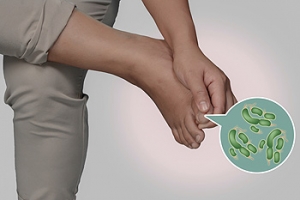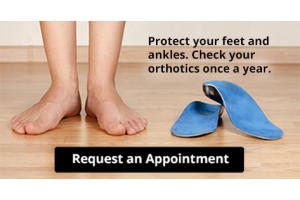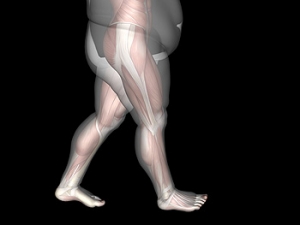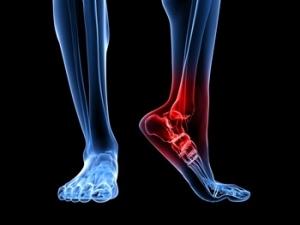Connect With Us
Featured Articles

Sports Related Foot and Ankle Injuries
Foot and ankle injuries are common among athletes and those who exercise frequently. Most of these injuries are non-life-threatening and can heal in weeks with proper treatment and care. Serious injuries, however, require urgent medical treatment.
Common minor injuries include ankle sprains, ankle strains, Achilles tendonitis, plantar fasciitis, stress fractures, and turf toe. An ankle sprain is when the ligaments in the ankle have either become stretched or torn. When the muscle or tendon is stretched or torn, it is an ankle strain. When the big toe is sprained, it is known as turf toe. Achilles tendonitis is the overuse and inflammation of the Achilles tendon. Plantar fasciitis is the inflammation of the plantar fascia and generally occurs from overuse in athletics. Stress fractures are also caused from overuse and are small cracks in the bone.
Achilles tendon ruptures are common, but more serious. This injury occurs when the Achilles tendon, the largest tendon in the body, ruptures. In most cases, this causes severe pain and difficulty walking; some who have experienced this injury have reported, however, no signs or symptoms. A laceration is a deep cut that can occur anywhere on the body. Lacerations on the foot are rarer, but can occur from things like metal cleats landing on the foot.
Treatment options cover a wide range of methods based upon the injury and its severity. Conditions like plantar fasciitis, stress fractures, Achilles tendonitis, turf toe and ankle sprains/ strains can heal on their own without immediate medical care, but seeing a podiatrist to monitor the injury is always recommended. Following the RICE (Rest, Icing, Compression, and Elevation) protocol is generally enough to treat minor injuries. This means resting the foot by either keeping pressure off the foot or not walking at all. Icing the injury will help reduce swelling and pain. Compressing the wound with a wrap will immobilize and help promote healing. Finally, keeping the wound elevated will also reduce swelling and also help the healing process.
It is important to note that even minor injuries can vary in severity, with grade one being a minor injury and grade three requiring urgent care by a podiatrist. Achilles tendon ruptures and lacerations on the foot generally require urgent medical care and treatment options that need a podiatrist. These could include imaging tests, stitches for cuts, rehabilitation, and casts or braces. Every case is different, however, so it is always recommended to see a podiatrist when pain in the foot does not disappear.
Are You Suffering From Ingrown Toenails?
Treatment Options for Fungal Nails
 Are your toenails thick, crumbling, or yellow? Do you find yourself avoiding certain activities and open-toed shoes for fear of someone seeing your nails? If so, you may be suffering from onychomycosis, or a fungal nail infection. Though it can be an embarrassing problem, you are definitely not the only one facing it. Approximately 10% of the general population is afflicted by a fungal nail infection. Beyond just their appearance, these infections can also cause toe and foot pain, lead to bacterial infections and ulcerations, and can even cause complications in people with diabetes. Topical or oral medications may help, though they are not always effective, and have the potential to lead to serious side effects. Laser treatment is another option that may be effective. If you have developed a toenail fungus, don’t hesitate to talk to a podiatrist who can help you select the treatment option that is best for you.
Are your toenails thick, crumbling, or yellow? Do you find yourself avoiding certain activities and open-toed shoes for fear of someone seeing your nails? If so, you may be suffering from onychomycosis, or a fungal nail infection. Though it can be an embarrassing problem, you are definitely not the only one facing it. Approximately 10% of the general population is afflicted by a fungal nail infection. Beyond just their appearance, these infections can also cause toe and foot pain, lead to bacterial infections and ulcerations, and can even cause complications in people with diabetes. Topical or oral medications may help, though they are not always effective, and have the potential to lead to serious side effects. Laser treatment is another option that may be effective. If you have developed a toenail fungus, don’t hesitate to talk to a podiatrist who can help you select the treatment option that is best for you.
If left untreated, toenail fungus may spread to other toenails, skin, or even fingernails. If you suspect you have toenail fungus it is important to seek treatment right away. For more information about treatment, contact Dr. Thong V. Truong of California. Our doctor can provide the care you need to keep you pain-free and on your feet.
Symptoms
- Warped or oddly shaped nails
- Yellowish nails
- Loose/separated nail
- Buildup of bits and pieces of nail fragments under the nail
- Brittle, broken, thickened nail
Treatment
If self-care strategies and over-the-counter medications does not help your fungus, your podiatrist may give you a prescription drug instead. Even if you find relief from your toenail fungus symptoms, you may experience a repeat infection in the future.
Prevention
In order to prevent getting toenail fungus in the future, you should always make sure to wash your feet with soap and water. After washing, it is important to dry your feet thoroughly especially in between the toes. When trimming your toenails, be sure to trim straight across instead of in a rounded shape. It is crucial not to cover up discolored nails with nail polish because that will prevent your nail from being able to “breathe”.
In some cases, surgical procedure may be needed to remove the toenail fungus. Consult with your podiatrist about the best treatment options for your case of toenail fungus.
If you have any questions, please feel free to contact our office located in Chico, CA . We offer the newest diagnostic and treatment technologies for all your foot care needs.
How to Treat Your Toenail Fungus
While not a serious issue, toenail fungus, or onychomycosis, can be an embarrassing and uncomfortable condition to experience. Toenail fungus is often caused from public areas that harbor fungi and improper cleaning/drying of the foot. Once infected, the fungus grows deeper into the nail and can be very hard to get rid of.
There are different types of fungus that cause toenail fungus. Dermatophytes, yeasts, and molds are the most frequent forms of fungus to infect the toenail. Dermatophytes are the most common among the three. Symptoms associated with fungal nails include the discoloration of the toenail, brittleness, and in some circumstances, a smell. Pain is rarely a symptom caused by toenail fungus.
Diagnosis of fungal nails is generally a rather quick process. However podiatrists will make sure that the cause is not another condition such as lichen planus, psoriasis, onychogryphosis, or nail damage. Podiatrists will make use of fungal cultures and microscopy to verify that it is fungus.
While over-the-counter ointments are readily available, most are ineffective. This is due to the fact that the nail is very protective and that the fungus slips in between the nail plate and bed. Podiatrists can offer oral medication which currently provides the best results.
Ultimately, prevention is the best line of defense against toenail fungus. Avoid unsanitary public showers. If you do use a public shower, use shower shoes to provide your foot with protection. Once you are finished showering, make sure to thoroughly dry your feet. Fungi thrive in warm, dark, and moist places like sweaty, warm feet that are left dark in shoes all day.
Excess Weight and Your Foot Health
 Being overweight or obese can put you at risk for a variety of health conditions, but did you know that it can also increase your risk of foot pain? Being overweight or obese puts extra pressure on your feet, potentially leading to strains, sprains, fallen arches, and a host of other foot and ankle problems. Furthermore, being overweight or obese increases your risk of developing diabetes, peripheral neuropathy, and peripheral artery disease, which are all associated with foot health problems, such as diabetic foot ulcers, loss of sensation, and poor circulation. Eating a balanced diet and regularly exercising can improve your overall health. Maintain your daily foot health by wearing padded socks and shoes to avoid injury to the feet, practicing good foot hygiene, and checking your feet regularly for cuts and bruises. Regular visits to a podiatrist can also help spot potential problems and prevent future ones. If you are experiencing foot pain, or want to learn more about what you can do to keep your feet healthy, consult with a podiatrist today.
Being overweight or obese can put you at risk for a variety of health conditions, but did you know that it can also increase your risk of foot pain? Being overweight or obese puts extra pressure on your feet, potentially leading to strains, sprains, fallen arches, and a host of other foot and ankle problems. Furthermore, being overweight or obese increases your risk of developing diabetes, peripheral neuropathy, and peripheral artery disease, which are all associated with foot health problems, such as diabetic foot ulcers, loss of sensation, and poor circulation. Eating a balanced diet and regularly exercising can improve your overall health. Maintain your daily foot health by wearing padded socks and shoes to avoid injury to the feet, practicing good foot hygiene, and checking your feet regularly for cuts and bruises. Regular visits to a podiatrist can also help spot potential problems and prevent future ones. If you are experiencing foot pain, or want to learn more about what you can do to keep your feet healthy, consult with a podiatrist today.
The more you weigh, the harder your feet must work to support your body. If you’re an obese individual and are concerned about your feet, contact Dr. Thong V. Truong from California. Our doctor can provide the care you need to keep you pain-free and on your feet.
Obesity and Your Feet
People who are overweight are putting more pressure on their ankles, knees, and hips as well as their feet. This unfortunately can lead to variety of different issues.
Problems & Complications Stemming from Obesity
- When the body is overweight, it tries to compensate by changing the way that it moves. An obese person may lean forward and put extra weight on the wrong part of the foot. This puts unnecessary stress on the feet.
- Obese people are also more likely to develop type II diabetes which is a condition that causes a lot of foot problems. People with diabetes often don’t feel the cuts and sores that they may have on their feet, which can lead to more complicated and severe issues.
- Plantar fasciitis is another foot condition that can be caused by obesity. Plantar fasciitis is an inflammation of the tissue along the bottom of the foot, which causes pain and stiffness while walking and climbing stairs.
If you have any questions, please feel free to contact our office located in Chico, CA . We offer the newest diagnostic and treatment technologies for all your foot care needs.
Obesity and the Feet
Obesity is a common problem in American society. Approximately one third of the U.S. population is obese. Obesity is defined as a body mass index greater than 30. Obesity has the power to affect different aspects of the body, and one of the most common problems it causes is foot pain. There have been many studies that found a connection between an increased BMI and foot problems. A simple activity such as walking up a flight of stairs can increase pressure on the ankle by four to six times.
Being overweight causes the body to compensate for the extra weight by changing the way it moves. Consequently, people who struggle with obesity commonly have arch problems in their feet. Obesity causes the arch to break by stretching the ligaments and tendons that hold the bones in the foot together. When the arch lowers, the foot may eventually fall flat. Collapsed foot arches fail to provide adequate shock absorption which eventually leads to foot pain. Other conditions that may be caused by flat feet are pronation, plantar fasciitis, weak ankles, and shin splints.
Foot problems that are caused by obesity may be treated by wearing proper footwear. Proper shoes will allow your feet to have better circulation around the arch and ankle. Additionally, those with obesity often discover that typical heel pain remedies are not effective for them. They will find that their plantar fascia is easily injured, and it is often inflamed. The best way to treat this problem is to implement lifestyle changes. A few good ways to improve your diet are to reduce calories, fill up on fruits and veggies, and to limit sugars.
Custom foot orthotics can prevent foot problems if you’re carrying excess weight or are trying to lose weight. The purpose of orthotics is to provide shock absorption to decrease the amount of stress on the joints to prevent arthritis.
Why Live with Pain and Numbness in Your Feet?
Sever’s Disease: Not as Scary as It Sounds
 If your child complains of foot pain and you take them to the podiatrist, hearing that they have been diagnosed with Sever’s disease can be frightening. Fortunately, Sever’s disease, or calcaneal apophysitis as it is sometimes called, sounds a lot worse than it really is. Rather than being an actual disease, Sever’s disease is an overuse injury. Simply put, it is an injury to the growth plate of the heel bone. Children’s heel bones are typically not done developing until the age of 14. As your child grows, new bone is forming in the heel’s growth plate, a weak area located at the back of the heel. Repetitive stress on this growth plate from participating in sports and activities that involve running and pounding on a hard surface, can cause inflammation and muscle strain. Your child may complain of pain in the back or bottom of the foot, fatigue, or pain while walking or doing sports. With the professional treatment, your child will soon be back on their feet. If you suspect that your child may have Sever’s disease, please visit a podiatrist for a proper diagnosis and treatment.
If your child complains of foot pain and you take them to the podiatrist, hearing that they have been diagnosed with Sever’s disease can be frightening. Fortunately, Sever’s disease, or calcaneal apophysitis as it is sometimes called, sounds a lot worse than it really is. Rather than being an actual disease, Sever’s disease is an overuse injury. Simply put, it is an injury to the growth plate of the heel bone. Children’s heel bones are typically not done developing until the age of 14. As your child grows, new bone is forming in the heel’s growth plate, a weak area located at the back of the heel. Repetitive stress on this growth plate from participating in sports and activities that involve running and pounding on a hard surface, can cause inflammation and muscle strain. Your child may complain of pain in the back or bottom of the foot, fatigue, or pain while walking or doing sports. With the professional treatment, your child will soon be back on their feet. If you suspect that your child may have Sever’s disease, please visit a podiatrist for a proper diagnosis and treatment.
Sever's disease often occurs in children and teens. If your child is experiencing foot or ankle pain, see Dr. Thong V. Truong from California. Our doctor can treat your child’s foot and ankle needs.
Sever’s Disease
Sever’s disease is also known as calcaneal apophysitis, which is a medical condition that causes heel pain I none or both feet. The disease is known to affect children between the ages of 8 and 14.
Sever’s disease occurs when part of the child’s heel known as the growth plate (calcaneal epiphysis) is attached to the Achilles tendon. This area can suffer injury when the muscles and tendons of the growing foot do not keep pace with bone growth. Therefore, the constant pain which one experiences at the back of the heel will make the child unable to put any weight on the heel. The child is then forced to walk on their toes.
Symptoms
Acute pain – Pain associated with Sever’s disease is usually felt in the heel when the child engages in physical activity such as walking, jumping and or running.
Highly active – Children who are very active are among the most susceptible in experiencing Sever’s disease, because of the stress and tension placed on their feet.
If you have any questions, please feel free to contact our office located in Chico, CA . We offer the newest diagnostic and treatment technologies for all your foot and ankle injuries.
Sever's Disease
Sever's disease, also known as calcaneal apophysitis, is a medical condition that causes heel pain in children’s feet while they’re growing. Sever's disease occurs most commonly in boys and girls between the ages of 8 and 14.
Sever's disease occurs when the child’s growth plate, or the calcaneal epiphysis, an area attached to the Achilles tendon, is injured or when the muscles and tendons of the growing foot do not keep pace with bone growth. The result is constant pain experienced at the back of the heel and the inability to put any weight on the heel. This forces the child to bear weight on their toes while walking. When a toe gait develops, the child must change the way they walk to avoid placing weight on the painful heel. If this is not properly addressed, this can lead to further developmental problems.
The most common symptom of Sever's disease is acute pain felt in the heel when a child engages in physical activity such as walking, jumping or running. Children who are active athletes are among the group most susceptible to experiencing Sever's disease. This is due to the extreme stress and tension placed on their growing feet. The rolling movement of the foot during walking or running and obesity are both additional conditions linked to causing Sever's disease.
The first step in treating Sever's disease is to rest the foot and leg and avoid physical activity. Over the counter pain-relieving and anti-inflammatory medications can be helpful for reducing the amount of heel pain. A child with Sever's disease should also wear shoes that properly support the heel and the arch of the foot. Consider purchasing orthotic shoe inserts which can help support the heel and foot while it is healing. Most patients with Sever's disease symptoms report an eventual elimination of heel pain after wearing orthotic insoles that support the affected heel.
Sever's disease may affect either one heel or both. It is important for a child experiencing heel pain to be examined by a foot doctor who can apply the squeeze test. The squeeze test compresses both sides of the heel in order to determine if there is intense pain. Discourage any child diagnosed with Sever's disease from going barefoot as this can intensify the problem. Apply ice packs to the affected painful heel two or three times a day for pain relief.
Exercises that help stretch the calf muscles and hamstrings are effective at treating Sever's disease. An exercise known as foot curling has also proven to be very effective at treating Sever's disease. When foot curling, the foot is pointed away from the body, then curled toward the body to help stretch the muscles. The curling exercise should be done in sets of 10 or 20 repetitions and repeated several times throughout the day.
Treatment methods can continue for at least 2 weeks and as long as 2 months before the heel pain completely disappears. A child can continue doing daily stretching exercises for the legs and feet to prevent Sever’s disease from returning.








